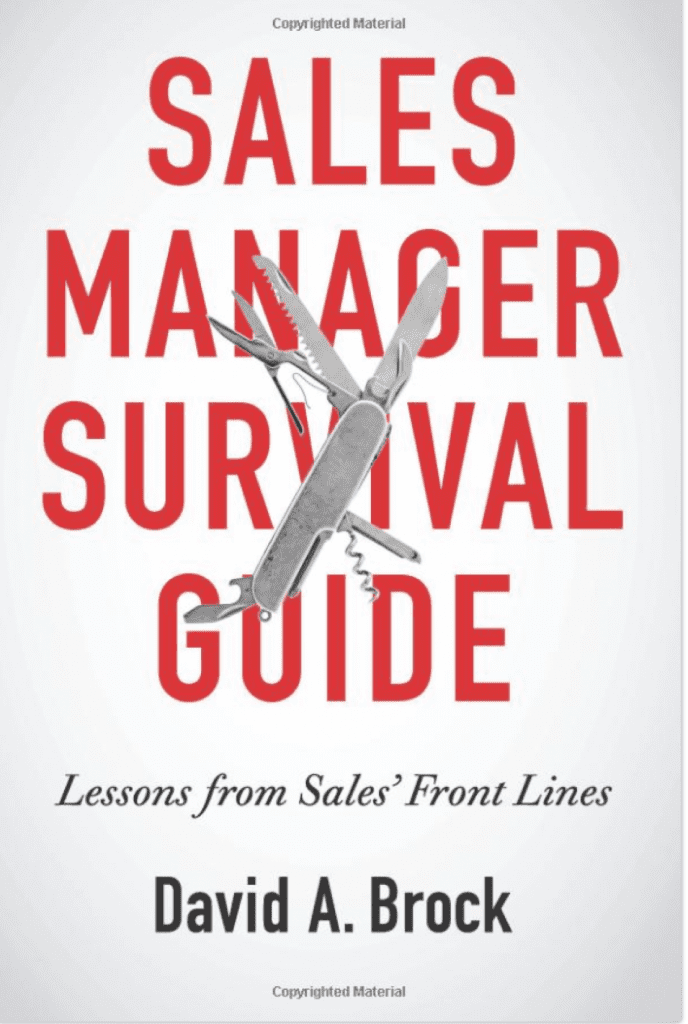A classic issue in sales forces is promoting one of the top performing sales reps to the manager of a sales team, then having them fail in this new role.
It can be a “triple whammy” for the company as they lose the revenue of a top performer, need to fill a critical “seat” in the sales organization and have a group of salespeople that are not performing to their full potential.
I just became much clearer on why this happens and what can be done about it, by reading just one section of David Brock’s book “The Sales Manager Survival Guide”.
Per David Brock, a sales manager’s job is to be a coach. This observation alone likely identifies why so many sales reps that are promoted to management fail. Being a top account executive, has almost nothing to do with coaching. I’d say reps promoted to management have no idea that they need to learn to be a coach. (I didn’t when it happened to me!)
David Brock goes on to define coaching as:
- About developing your people’s skills
- Addressing attitudes and behaviors that may need to be modified to increase your team members’ job performance
- Helping people to think, so they can solve problems for themselves
A key insight in the book for me has to do with the nitty-gritty of asking the right questions to coach someone, to help them think through their situation and find solutions.
David has a whole section of questions you can ask but he also points out that these questions may be familiar to many salespeople because they are structured in a similar way to Neil Rackham’s classic SPIN Selling methodology.
This was an “aha moment” for me as it shows a clear path for a top-performing rep to become a top-performing sales manager. If the rep is familiar with a sales methodology like SPIN (most account executives use something similar), they can use this same framework to become a great coach (and hence great sales manager).
For those who don’t know SPIN Selling, here is the basic structure:
- Situation: Ask questions to understand the situation. Most salespeople are fairly skilled at this, at least if they have picked up some form of “solution selling”. In a sales management context, you may be asking questions about a deal stuck in the pipeline, a proposal that has been submitted etc. vs asking questions about your prospect’s situation.
- Problem: Here’s where you start really diagnosing. You need to understand what problems your salesperson is facing. Once you get a response, it generally makes sense to drill down on the areas mentioned in the response. Keep discovering problems until you think you clearly understand the picture.
- Implication: Explore the implications of the problems you’ve discovered in step 2. This is essentially a bit of a “pain amplification” exercise but hopefully done in good spirit. These questions help your team member really understand the true cost of these problems.
- Need-Payoff: This stage is a counterpart to step 3. It’s about saying, “so if that problem were solved what would that do for you?” For example, “if you closed 40% or your proposals instead of 20%, what would that do for your sales (and commission) this year?”
Coaching a member of the sales team using this framework now seems fairly simple to me. You discuss a situation they are facing in their selling, explore the consequences of this problem (like a deal not closing), the payoff from this happening (the deal closing) and then brainstorm together possible solutions to this problem together. This helps the salesperson (and you) become better at thinking though solutions in the future.
David points out that as coaching is so critical it is something that needs to happen all the time. It should be built in to all your interactions with your team. All business meetings should incorporate coaching elements.
There’s a lot of great insight in just this one section of David Brock’s book. I may well come back and cover another section of the book in future. If you want to be a great sales manager, go grab a copy here.
